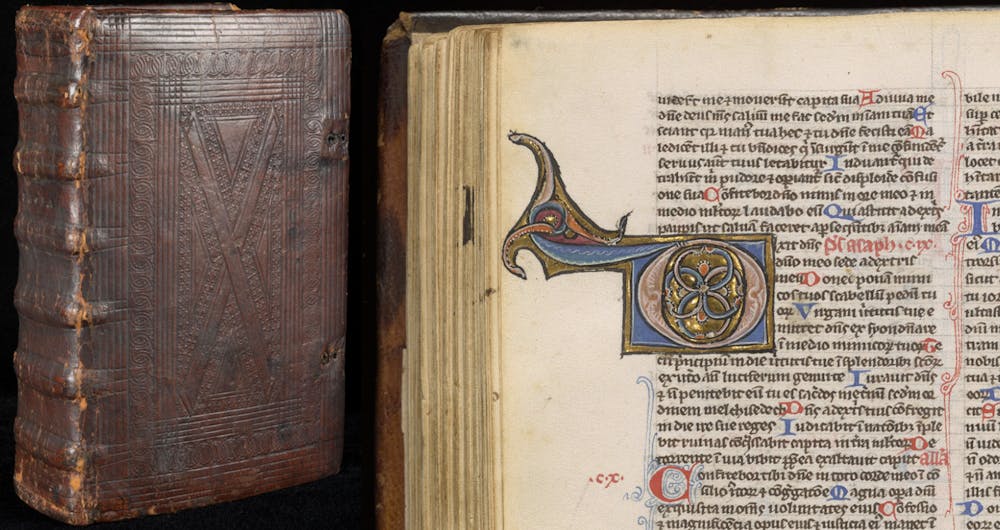In 1979, Ohio University’s Alden Library acquired its millionth volume in the collection: the Biblia Latina. Now, over 40 years later, the bible has been digitized in the OU Digital Archives, bringing the knowledge within the pages to a wider audience.
The Biblia Latina was a donation to the rare books collection of Alden. This donation was incredibly meaningful to the staff not only because it was the millionth volume, but it also was and remains one of the most important items in the rare book collection and arguably across all collections in terms of usage from students, faculty and staff.
Miriam Intrator, special collections librarian for rare books, highlights the importance of the volume, especially its handcrafting in the 13th century, complete with handwritten lettering on parchment and colorful decoration made from minerals, plants, gems and even gold leaf pounded flat and adhered to the page.
“You can also tell by all the handwritten notes, corrections, doodles, and other markings within that it passed through many different hands over the course of its life and before it arrived at Ohio University,” Intrator said in an email. “It’s fun to think about who all those people might have been and their interest in the Bible.”
Erin Wilson, digital imaging specialist and lab manager, was thrilled to begin the digitization process on the Biblia Latina.
“It feels great to realize a long-awaited dream to have the Biblia Latina digitized, and to know that more people will have access to it than ever before,” Wilson said in an email. “I often feel like digitization is a way of promoting our Libraries’ unseen treasures and drawing attention to our unique holdings, of which the millionth volume is arguably the most prized!”
This most-prized volume, as well as the other digitized volumes, went through a lot of work to make it in the digital archives. First, the volume must be evaluated by a technician, collection curator, conservation expert or sometimes all three, like the Biblia Latina. The evaluation considers the volume’s age, condition, format and structural characteristics to ensure the safest capture method.
There are several different ways to digitize a volume, including a flatbed scanner for standard documents, or a digital single-lens reflex (DSLR) camera matched with the support of a cradle for bound volumes, like the Biblia Latina. If safety is the first priority, image quality is a close runner-up.
Wilson feels the Biblia Latina is a really interesting addition to the collection, not only for the information within, but for the details found within. For example, the hair follicles found on the page made of animal skin or the gold leaf pressed to the page. The digital image enhances the viewing experience by allowing higher levels of magnification.
“Our goal is to provide a virtual experience that recreates the same awe and perception that one might have when viewing the artifact in person,” Wilson said.
Awe is just one word that Miriam Shadis, an associate professor of history, would use to describe the volume.
Shadis talks about the volume in almost every class she teaches. Once in a while, she’ll bring students to the archive to see it. It’s her way of showing her students that the Middle Ages were concrete and real, not just an abstraction discussed in a classroom setting. In addition, Shadis also teaches her students about the role of books in learning, as well as how books are made. The Biblia Latina is the perfect example to pair with her teachings.
“I think it’s absolutely wonderful that we have this medieval Bible in our collection –– we are really fortunate to have such a beautiful and unique book!” Shadis said in an email.
Shadis expressed her admiration for the fact that rare books like these are being put into the digital archives. All three women believe that because rare books can’t be checked out or really utilized in a hands-on way for research, digitizing the volume is an incredible way to increase the Biblia Latina’s reach.
At this point, Alden has over three million volumes in its collection. Even more than that when considering the electronic resources that are provided for OU. Intrator is proud to see the library continue to add to the collections, as well as create digital resources to provide to those who need them.
“The Bible became the millionth volume when it was acquired in 1979,” Intrator said in an email. “So we’ve grown a lot since then and are still growing. It’s exciting to know that we have materials in our collections able to meet most of the teaching, learning, research and other needs and interests of our users.”






